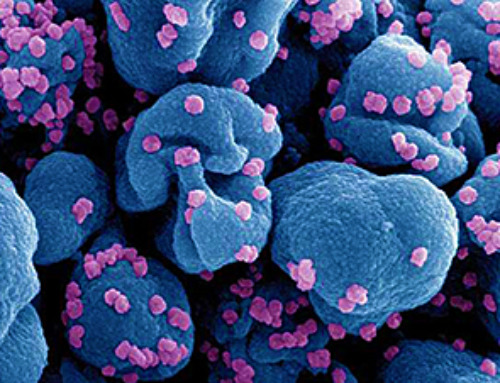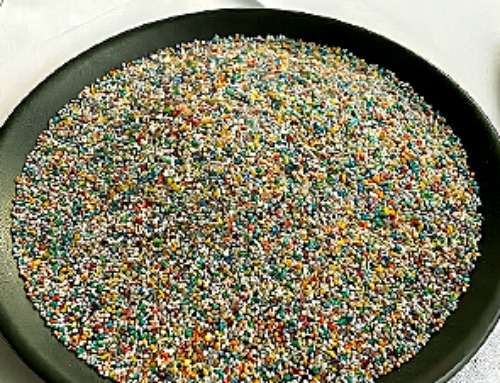Research carried out at Oxford’s Nuffield Department of Clinical Neurosciences has led to the development of a new blood-based test to identify the pathology that triggers Parkinson’s disease before the main symptoms occur. This could allow clinicians to screen for those individuals at high risk of developing the disease and facilitate the timely introduction of precision therapies that are currently at clinical trial stage.
Parkinson’s disease starts more than ten years before patients come to the clinic with symptoms because their brain cells fail to handle a small protein called alpha-synuclein. This leads to the formation of abnormal clumps of alpha-synuclein which damage vulnerable nerve cells, causing the familiar movement disorder and often dementia. By the time people are diagnosed with Parkinson’s disease, most of these vulnerable nerve cells have already died and alpha-synuclein clumps have formed in many brain regions.
It would be useful if there was a way to predict whether the pathways that handle alpha-synuclein are impaired before the onset of Parkinson’s symptoms. This could help clinicians to identify people most likely to benefit from disease-modifying therapies when they become available.
In the paper, “Neuronally Derived Extracellular Vesicle α-Synuclein as a Serum Biomarker for Individuals at Risk of Developing Parkinson Disease” in JAMA Neurology, Shijun Yan and colleagues in the Tofaris lab revealed the promise of measuring a subtype of extracellular vesicles to identify changes in alpha-synuclein in people who are likely to develop Parkinson’s disease. Extracellular vesicles are nanoparticles that are released by all cell types and circulate in biofluids including blood, transporting molecular signals between cells.
Using an improved antibody-based assay developed by the research group, the test involves isolating those extracellular vesicles originating from nerve cells from blood, and then measuring their alpha-synuclein content. Professor George Tofaris explains, “A robust assay is crucial because neuronally-derived extracellular vesicles constitute less than 10% of all circulating vesicles, and ~99% of alpha-synuclein in blood is released from peripheral cells, mostly red blood cells.”
In the first study of its kind, the team looked at 365 at-risk individuals from four clinical cohorts (Oxford Discovery, Marburg, Cologne and the US-based Parkinson’s Progression Markers Initiative), 282 healthy controls and 71 people with genetic or sporadic Parkinson’s disease.
They found that those with the highest risk of developing Parkinson’s (more than 80% probability based on research criteria) had a two-fold increase in alpha-synuclein levels in neuronal extracellular vesicles and the test could accurately differentiate them from those with low risk (less than 5% probability) or healthy controls. Overall, the test could distinguish an individual with high risk of developing Parkinson’s from a healthy control with 90% probability.
These findings indicate that the blood test, together with a limited clinical assessment, could be used to screen and identify people who are at high risk of getting the disease. In further analysis, the test could also identify those who had evidence of neurodegeneration detected by imaging, or pathology detected by a spinal fluid assay, but had not yet developed a movement disorder or dementia.
In a small subgroup of 40 people who went on to develop Parkinson’s and related dementia, the blood test was positive in more than 80% of cases up to as much as seven years before the diagnosis.
In this group, there was a trend for higher levels of alpha-synuclein in neuronal extracellular vesicles in the blood to be associated with lower alpha-synuclein in the spinal fluid, and a longer interval before the onset of the main symptoms of Parkinson’s disease. This suggests that the nerve cells may protect themselves by packaging excess alpha-synuclein in extracellular vesicles which are then released in the blood.
The research builds on earlier findings by the Tofaris lab, also confirmed in the current study, showing that the biomarker is increased in patients with Parkinson’s disease but not in other Parkinson’s-like conditions.
The Tofaris lab, which is part of the Nuffield Department of Clinical Neurosciences and based in the Kavli Institute for Nanoscience Discovery, previously delineated the pathway which targets alpha-synuclein for destruction inside nerve cells. This pathway may also direct alpha-synuclein outside cells in extracellular vesicles, when intracellular protein turnover is inefficient in conditions such as aging and Parkinson’s disease.
Professor Tofaris said, “Collectively our studies demonstrate how fundamental investigations in alpha-synuclein biology can be translated into a biomarker for clinical application, in this case for the identification and stratification of Parkinson’s risk. A screening test that could be implemented at scale to identify the disease process early is imperative for the eventual instigation of targeted therapies as is currently done with screening programs for common types of cancer.”
More information: Shijun Yan et al, Neuronally Derived Extracellular Vesicle α-Synuclein as a Serum Biomarker for Individuals at Risk of Developing Parkinson Disease, JAMA Neurology (2023). DOI: 10.1001/jamaneurol.2023.4398
News
Older chemical libraries show promise for fighting resistant strains of COVID-19 virus
SARS‑CoV‑2, the virus that causes COVID-19, continues to mutate, with some newer strains becoming less responsive to current antiviral treatments like Paxlovid. Now, University of California San Diego scientists and an international team of [...]
Lower doses of immunotherapy for skin cancer give better results, study suggests
According to a new study, lower doses of approved immunotherapy for malignant melanoma can give better results against tumors, while reducing side effects. This is reported by researchers at Karolinska Institutet in the Journal of the National [...]
Researchers highlight five pathways through which microplastics can harm the brain
Microplastics could be fueling neurodegenerative diseases like Alzheimer's and Parkinson's, with a new study highlighting five ways microplastics can trigger inflammation and damage in the brain. More than 57 million people live with dementia, [...]
Tiny Metal Nanodots Obliterate Cancer Cells While Largely Sparing Healthy Tissue
Scientists have developed tiny metal-oxide particles that push cancer cells past their stress limits while sparing healthy tissue. An international team led by RMIT University has developed tiny particles called nanodots, crafted from a metallic compound, [...]
Gold Nanoclusters Could Supercharge Quantum Computers
Researchers found that gold “super atoms” can behave like the atoms in top-tier quantum systems—only far easier to scale. These tiny clusters can be customized at the molecular level, offering a powerful, tunable foundation [...]
A single shot of HPV vaccine may be enough to fight cervical cancer, study finds
WASHINGTON -- A single HPV vaccination appears just as effective as two doses at preventing the viral infection that causes cervical cancer, researchers reported Wednesday. HPV, or human papillomavirus, is very common and spread [...]
New technique overcomes technological barrier in 3D brain imaging
Scientists at the Swiss Light Source SLS have succeeded in mapping a piece of brain tissue in 3D at unprecedented resolution using X-rays, non-destructively. The breakthrough overcomes a long-standing technological barrier that had limited [...]
Scientists Uncover Hidden Blood Pattern in Long COVID
Researchers found persistent microclot and NET structures in Long COVID blood that may explain long-lasting symptoms. Researchers examining Long COVID have identified a structural connection between circulating microclots and neutrophil extracellular traps (NETs). The [...]
This Cellular Trick Helps Cancer Spread, but Could Also Stop It
Groups of normal cbiells can sense far into their surroundings, helping explain cancer cell migration. Understanding this ability could lead to new ways to limit tumor spread. The tale of the princess and the [...]
New mRNA therapy targets drug-resistant pneumonia
Bacteria that multiply on surfaces are a major headache in health care when they gain a foothold on, for example, implants or in catheters. Researchers at Chalmers University of Technology in Sweden have found [...]
Current Heart Health Guidelines Are Failing To Catch a Deadly Genetic Killer
New research reveals that standard screening misses most people with a common inherited cholesterol disorder. A Mayo Clinic study reports that current genetic screening guidelines overlook most people who have familial hypercholesterolemia, an inherited disorder that [...]
Scientists Identify the Evolutionary “Purpose” of Consciousness
Summary: Researchers at Ruhr University Bochum explore why consciousness evolved and why different species developed it in distinct ways. By comparing humans with birds, they show that complex awareness may arise through different neural architectures yet [...]
Novel mRNA therapy curbs antibiotic-resistant infections in preclinical lung models
Researchers at the Icahn School of Medicine at Mount Sinai and collaborators have reported early success with a novel mRNA-based therapy designed to combat antibiotic-resistant bacteria. The findings, published in Nature Biotechnology, show that in [...]
New skin-permeable polymer delivers insulin without needles
A breakthrough zwitterionic polymer slips through the skin’s toughest barriers, carrying insulin deep into tissue and normalizing blood sugar, offering patients a painless alternative to daily injections. A recent study published in the journal Nature examines [...]
Multifunctional Nanogels: A Breakthrough in Antibacterial Strategies
Antibiotic resistance is a growing concern - from human health to crop survival. A new study successfully uses nanogels to target and almost entirely inhibit the bacteria P. Aeruginosa. Recently published in Angewandte Chemie, the study [...]
Nanoflowers rejuvenate old and damaged human cells by replacing their mitochondria
Biomedical researchers at Texas A&M University may have discovered a way to stop or even reverse the decline of cellular energy production—a finding that could have revolutionary effects across medicine. Dr. Akhilesh K. Gaharwar [...]





















